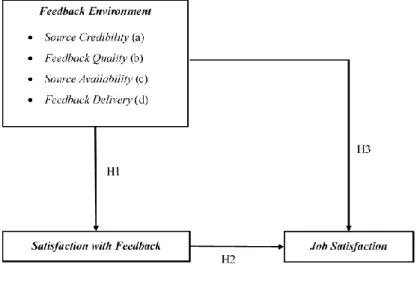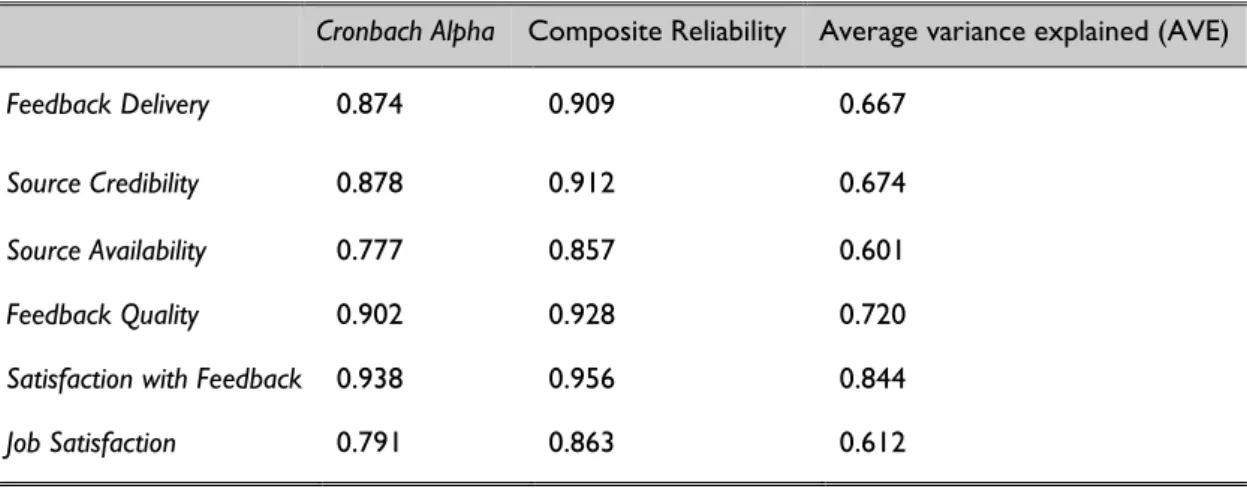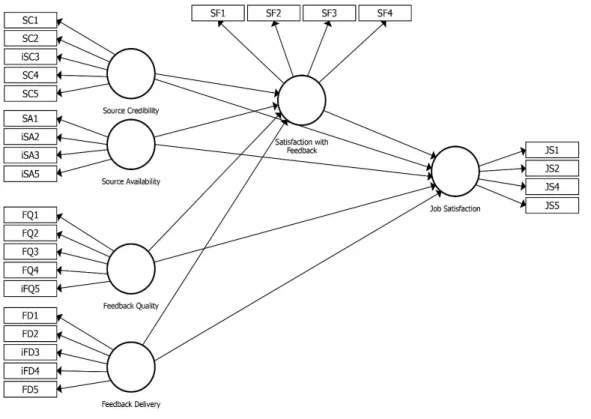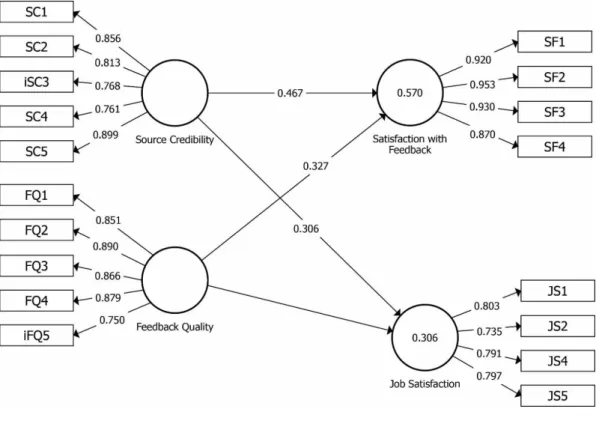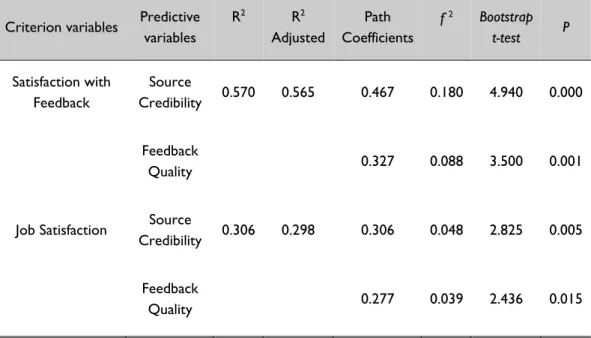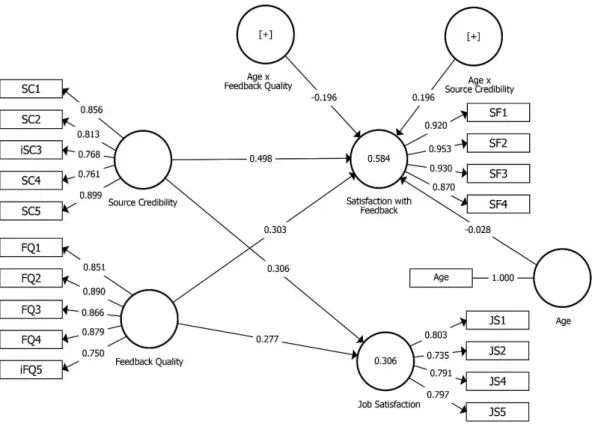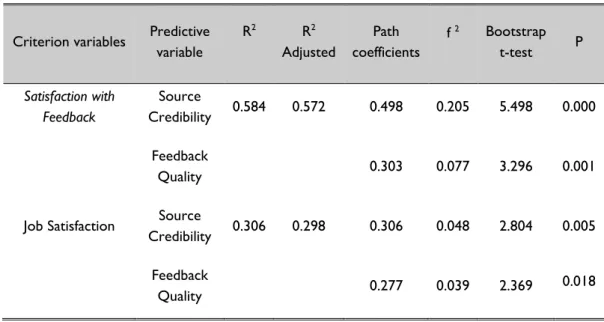DOI: http://dx.doi.org/10.5455/EJMS/288977/2018 85 The European Journal of Management
Studies is a publication of ISEG, Universidade de Lisboa. The mission of EJMS is to significantly influence the domain of management studies by publishing innovative research articles. EJMS aspires to provide a platform for thought leadership and outreach. Editors-in-Chief:
Luís M. de Castro, PhD
ISEG - Lisbon School of Economics and Management, Universidade de Lisboa, Portugal
Gurpreet Dhillon, PhD
The University of North Carolina, Greensboro, USA
Tiago Cardão-Pito, PhD
ISEG - Lisbon School of Economics and Management, Universidade de Lisboa, Portugal
Managing Editor: Mark Crathorne, MA
ISEG - Lisbon School of Economics and Management, Universidade de Lisboa, Portugal
ISSN: 2183-4172 DOI: 10.5455/EJMS. Volume 23, Issue 2 www.european-jms.com
Copyright © 2018 - ISEG, Universidade de Lisboa
THE RELEVANCE OF FEEDBACK
ENVIRONMENT
FOR
JOB
SATISFACTION
Pilar Mosquera1, Maria Eduarda Soares1, and
Filomena Ribeiro2
1ISEG – Lisbon School of Economics and
Management, Universidade de Lisboa, and
ADVANCE; 2ISEG – Lisbon School of Economics
and Management, Universidade de Lisboa, Portugal
Abstract
The effectiveness of feedback given by managers in performance appraisal processes is largely influenced by situational factors and has important repercussions for employee performance and satisfaction. This study attempts to clarify the role played by two situational factors, Feedback Environment and Satisfaction with Feedback, for employee Job Satisfaction. Using a sample of 170 participants, the study analyses a conceptual framework and tests hypotheses through Partial Least Squares (PLS).
Results indicate an impact of two dimensions of Feedback Environment, namely Source Credibility and Feedback Quality, for both Satisfaction with Feedback and Job Satisfaction. It was also found that age is a moderator of the relationship between the two Feedback Environment dimensions and Satisfaction with Feedback: the older the employees, the lower the effect of Feedback Quality and the higher the effect of Source Credibility for Satisfaction with Feedback. Contrary to expectations, Satisfaction with Feedback does not mediate the relationship between Feedback Environment and Job Satisfaction.
Key words: Performance appraisal, feedback environment, satisfaction with feedback, job satisfaction.
86
Introduction
Feedback is widely recognised as being one of the most relevant aspects of performance appraisal (PA) processes, with significant impacts on both individuals and organisations (e.g., Jawahar, 2010). Feedback allows employees to become more aware of their performance, and is positively associated with learning, motivation, job satisfaction, organisational commitment (Aguinis et al., 2012; Kuchinke, 2000; Ozturk et al., 2014) and performance (Jawahar, 2006a; Kluger and DeNisi, 1996). Consequently, feedback is frequently used as a tool to influence employees’ behaviours and attitudes (Hirst and Reed, 2015) and to improve the dialogue between employees and managers (Kuchinke, 2000).
While the importance and benefits of feedback have been widely recognised, some empirical evidence shows that feedback does not always lead to improved performance (Alvero et al., 2001; DeNisi and Kluger, 2000; Kluger and DeNisi, 1996). Kluger and DeNisi (1996) found that feedback only led to better performance in two thirds of the cases studied, and in the remaining third it even worsened performance. These results put forward the possibility that feedback mechanisms are not fully understood and that they also indicate the importance of analysing the situational factors in which feedback occurs, i.e., the Feedback Environment (Steelman et al., 2004), as well as the reactions of employees to the feedback provided, namely Satisfaction with Feedback (Jawahar, 2006a).
According to Steelman et al. (2004), Feedback Environment refers to the contextual aspects of everyday interactions related to feedback processes between superiors and subordinates and between peers. In other words, it is not limited to feedback provided in the formal PA sessions. Steelman et al. (2004) developed and validated a measure of Feedback Environment, which they called the Feedback Environment Scale (FES). This scale includes seven facets: Source Credibility (expertise and trustworthiness); Feedback Quality (consistency and usefulness); Source Availability (amount of contact with source and ease of obtaining feedback); Feedback Delivery (the way feedback is delivered, including consideration for the person appraised); Favourable Feedback (perceived frequency of positive feedback); Unfavourable Feedback (perceived frequency of negative feedback); and Promotes Feedback Seeking (support and encouragement to seek feedback). In this study, only the first four facets of the scale were used. This decision was mainly due to parsimony concerns and the length of the questionnaire and therefore we decided to focus on the facets that appeared to be more relevant in the context of our study. Although Steelman et al. (2004) considered two different sources of feedback (supervisor and co-worker) we have limited our study to just one source - the supervisor - as in the Portuguese context the supervisor is still the main source of feedback, and in most cases is the only source.
Satisfaction with Feedback is considered to be one of the most important reactions to PA feedback (Giles and Mossholder, 1990; Keeping and Levy, 2000), as well as having considerable consequences for attitudes and future behaviours of individuals in organisations (Taylor et al., 1984, in Jawahar, 2006b). Levy and Williams (2004) argue that when receivers are not satisfied
87 with feedback, the content of the feedback will probably be ignored. According to Jawahar (2006a), Satisfaction with Feedback in PA depends on several situational factors: ratings resulting from PA; perceptions of the appraised regarding their participation in the process; satisfaction with the appraiser, and; satisfaction with the appraisal system. Other authors (e.g., London and Smither, 2002; Steelman et al., 2004) have provided evidence of the role played by Feedback Environment for Satisfaction with Feedback. Hence we propose the following research hypothesis and sub-hypotheses:
H1: Feedback Environment is positively associated with Satisfaction with Feedback. H1a: Source Credibility is positively associated with Satisfaction with Feedback H1b: Feedback Quality is positively associated with Satisfaction with Feedback H1c: Source Availability is positively associated with Satisfaction with Feedback H1d: Feedback Delivery is positively associated with Satisfaction with Feedback
Although several authors have recognised the value of feedback in PA processes and the relevance of Satisfaction with Feedback (Ilgen et al., 1979; Keeping and Levy, 2000), not much research has been carried out on the topic, especially regarding the impact of Satisfaction with Feedback for work and attitudes in organisations (Ilgen et al., 1981). An exception can be found in the work of Jawahar (2006a; 2006b), who conducted two investigations focusing on Satisfaction with Feedback in PA. In both cases, results indicated that Satisfaction with Feedback of PA is positively associated with job satisfaction and organisational commitment, and is negatively associated with turnover intentions. Based on the results of Jawahar (2006a; 2006b), we formulate the following hypothesis:
H2: Satisfaction with Feedback is positively associated with Job Satisfaction.
Job satisfaction is one of the most studied concepts in the Organisational Behaviour literature (Dormann and Zapf, 2001). This is mainly due to the effects it has on individuals and organisations, especially on employee absenteeism, retention, performance, commitment, turnover intentions, and manager-subordinate relationships. Job satisfaction includes an affective dimension related to feelings generated by experiences at work, as well as a cognitive dimension, which is related to the evaluation of various facets of a job according to previous expectations and standards (Organ and Kanovsky, 1989; Schlett and Ziegler, 2014; Weiss, 2002)
Given the fact that it is the role of managers to structure the work environment and to provide feedback to employees, motivating and supporting them, it is not surprising that among the facets most connected with the manager-subordinate relationship, Feedback Environment has been associated with Job Satisfaction in several studies (e.g., Anseel and Lievens, 2007; Rosen et al.,
88
2006; Sparr and Sonnentag, 2008). Based on these studies, we formulate the following hypothesis and sub-hypotheses:
H3: Feedback Environment is positively associated with Job Satisfaction H3a: Source Credibility is positively associated with Job Satisfaction H3b: Feedback Quality is positively associated with Job Satisfaction H3c: Source Availability is positively associated with Job Satisfaction H3d: Feedback Delivery is positively associated with Job Satisfaction
Figure 1 presents the research model that will be analysed in this study, based on the above-mentioned hypotheses.
Figure1: Research Model Method
Participants and Procedure
An online questionnaire was sent by Survey Monkey to employees of two organisations. Of the 1,432 questionnaires sent out, only 171 were returned, equating to a response rate of 12%. After excluding one participant, who was clearly an outlier, a total sample of 170 participants was obtained, of which 54.1% are male and 45.9% are female. The average age is 41 years, the majority (57.6%) do not have a university degree, and only 30.6% are in management positions. As far as tenure is concerned, 42.4% have been in the organisation for less 10 years, 31.2% between 10 and 20 years, and 26.5% for more than 20 years.
89 Instruments
The questionnaire used consists of two sections. The first section refers to participants’ perceptions of Feedback Environment, Satisfaction with Feedback and Job Satisfaction. The three measures used total 29 items, for which a 5-point Likert scale was used, where 1 = totally disagree and 5 = totally agree. The original items, which were written in English, were translated into Portuguese. A back-translation into English followed, to ensure item equivalence in the two languages (Brislin, 1996). The second part of the questionnaire includes five demographic variables, namely: gender; age; education level; tenure, and; managerial position (yes/no). A pre-test was conducted with 10 persons of different departments, to ensure clarity of the instrument. Feedback Environment was measured by the Feedback Environment Scale (FES) of Steelman et al. (2004), which has high reliability (Cronbach alpha = 0.95). Even though this scale has seven dimensions, only four were used, as previously mentioned. These were: Source Credibility; Feedback Quality; Source Availability, and Feedback Delivery. Each dimension was measured with 5 items and the total scale therefore included 20 items. Satisfaction with Feedback was measured with the 4-item scale of Russell and Goode (1988), also used by Jawahar (2006b), which presented good reliability (Cronbach alpha = 0.89). Job Satisfaction was measured with the 5-item scale of Kaya et al. (2010), which also presented good reliability (Cronbach alpha = 0.90).
Results
Given the objective to study hypotheses grouped in a model, a decision was made to use structural equations modelling (SEM). As it was not possible to presume the normality of indicators in the study’s sample, the Partial Least Squares (PLS) method appeared to be the most adequate choice (Marôco, 2010). Data was analysed with the SmartPLS version 3.0 software (Ringle et al., 2015).
Measurement Model
As the model under study being a reflective1 measurement model, we proceeded to analyse the reliability and validity of the scales. To analyse reliability, we used Cronbach’s Alpha and compositor reliability, with a threshold value of 0.70 (Hair et al., 2011; Nunnally and Bernstein, 1994). When testing the reliability of indicators, two (SA4 and JS3) were found to have a standardised factor loading of below 0.7 and thus these were excluded from subsequent analyses. The remaining indicators presented high means (between 3.36 and 4.36), where it is noteworthy that Job Satisfaction has higher means than Satisfaction with Feedback. As far as the reliability of the constructs is concerned, results indicate good levels of internal consistency, with Cronbach alphas and composite reliabilities above 0.7 (Table 1).
90
Cronbach Alpha Composite Reliability Average variance explained (AVE)
Feedback Delivery 0.874 0.909 0.667
Source Credibility 0.878 0.912 0.674
Source Availability 0.777 0.857 0.601
Feedback Quality 0.902 0.928 0.720
Satisfaction with Feedback 0.938 0.956 0.844
Job Satisfaction 0.791 0.863 0.612
Table 1: Reliability and validity measures
Convergent validity was measured through the Average Variance Extracted (AVE), where the threshold of acceptable values is 0.50 (Hair et al., 2011; Henseler et al., 2009; Sarstedt et al., 2014). As shown in Table 1, the percentage of AVE exceeds 50% in all constructs. To complement the analysis of convergent validity, we calculated the bootstrap t-statistics of the indicators’ standardised loadings. All indicators presented significant factor loadings (t>3.29; p<0.001) and therefore none was excluded. All measurement models present convergent validity. For the analysis of discriminant validity, we used the criterion of Fornell and Larcker (1981). Table 2 shows that the square roots of the AVE are higher than the correlations and therefore we can conclude that there is evidence of discriminant validity (Hair et al., 2011).
Feedback Delivery Source Credibility Source Availability Feedback Quality
Satisfaction with Feedback Job Satisfaction Feedback Delivery 0.817 Source Credibility 0.733 0.821 Source Availability 0.652 0.733 0.775 Feedback Quality 0.713 0.803 0.656 0.849 Satisfaction with Feedback 0.636 0.730 0.560 0.701 0.919 Job Satisfaction 0.362 0.527 0.462 0.521 0.429 0.782 Table 2: Discriminant Validity
91 Structural model
The analysis of the measurement models concluded that they all present good levels of reliability, as well as convergent and discriminant validity. These results enabled us to proceed to the analysis of the structural model (Figure 2) to test the research hypothesis (Henseler et al., 2009).
Figure 2: Initial Structural Model
Using bootstrapping and pseudo t-tests to analyse the significance of the path coefficients, it was found that Source Availability presented a t value below 1.96 (p <0.05) for both Satisfaction with Feedback and Job Satisfaction. Therefore, a decision was made to exclude this variable from the model. We can also conclude that hypotheses H1b and H3b are not validated, that is to say, Source Availability is not positively and significantly associated with Satisfaction with Feedback (H1b) and Job Satisfaction (H3b).
We conducted bootstrapping with the new model and it was found that Feedback Delivery presented a t value below 1.96 (p <0.05) for both Satisfaction with Feedback and Job Satisfaction. Given this result, Feedback Delivery was excluded from the model and we can conclude that hypotheses H1d and H3d are not validated. In other words, Feedback Delivery is not significantly associated with Satisfaction with Feedback (H1d) and Job Satisfaction (H3d).
92
Excluding the two above-mentioned variables and carrying out bootstrapping again, we found that the relationship between Satisfaction with Feedback and Job Satisfaction had a t value below 1.96 (p <0.05). Therefore, H2 is not validated, as Satisfaction with Feedback is not positively and significantly associated with Job Satisfaction. On the other hand, this also means that Satisfaction with Feedback does not mediate the relationship between Feedback Environment and Job Satisfaction, as the initial model suggested. Finally, we conducted bootstrapping of the new model (Figure 3) and proceeded to evaluate it.
Figure 3: Final Structural Model
We started by analysing the coefficient of determination (R2) of the endogenous constructs in order to evaluate the explanatory power of the model (Sarstedt et al., 2014). The model explains 57% of variance for Satisfaction with Feedback and 30.6% of variance for Job Satisfaction.
Subsequently, we analysed the path coefficients in order to observe the direction, magnitude, and significance of each hypothesis in the final model. Table 3 shows that Source Credibility has a positive and significant effect on Satisfaction with Feedback (path coefficient= 0.467; p <0.000) as well as on Job Satisfaction (path coefficient= 0.306; p <0.005). Hypotheses H1a and H3a are therefore validated.
93 The construct Feedback Quality also has a positive and significant effect on Satisfaction with Feedback (path coefficient= 0.327; p <0.001) and on Job Satisfaction (path coefficient= 0.277; p <0.015), thus validating hypotheses H1c e H3c.
Criterion variables Predictive variables R2 R2 Adjusted Path Coefficients f 2 Bootstrap t-test P Satisfaction with Feedback Source Credibility 0.570 0.565 0.467 0.180 4.940 0.000 Feedback Quality 0.327 0.088 3.500 0.001
Job Satisfaction Source
Credibility 0.306 0.298 0.306 0.048 2.825 0.005
Feedback
Quality 0.277 0.039 2.436 0.015
Table 3: Results for the Final Structural Model
Effect sizes were analysed through f 2 (Cohen, 1988). According to Cohen (1988), the values of f 2 are 0.02 for weak effects, 0.15 for moderate, and 0.35 for strong. Results show that only Source Credibility has a moderate effect on Satisfaction with Feedback, the remaining effects being weak. Finally, we conducted blindfolding to calculate Stone–Geisser’s Q2 to evaluate the predictive relevance of the model. When the value of Q2 is higher than zero, this means than the exogenous constructs have predictive relevance for the endogenous construct under study (Hair et al., 2011). In this study the value of Q2 was above zero for both Satisfaction with Feedback and for Job
Satisfaction (0.479 and 0.169, respectively), which allows us to conclude that the model has predictive relevance.
Moderation effects
Subsequently, we attempted to analyse the possible moderator effects of the demographic variables included in the study, and a new model was tested (Figure 4).
94
Figure 4: Structural Model with Moderation
The results show that only Age has a moderator effect: The older the individual, the lower the effect of Feedback Quality and the higher the effect of Source Credibility for Satisfaction with Feedback.
Table 4 shows that the model with moderation (Figure 4) enables a better explanation of the variance of Satisfaction with Feedback (58.4%) when compared with the model without moderation (57.0%). The effect size of Source Credibility on Satisfaction with Feedback is higher, but still moderate (f 2 = 0,205). The model also presents values of Q2 above 0 (Q2 = 0.489 for Satisfaction
with Feedback and Q2 = 0.169 for Job Satisfaction), which suggests that the model has predictive
95 Criterion variables Predictive
variable R2 R2 Adjusted Path coefficients f 2 Bootstrap t-test P Satisfaction with Feedback Source Credibility 0.584 0.572 0.498 0.205 5.498 0.000 Feedback Quality 0.303 0.077 3.296 0.001
Job Satisfaction Source
Credibility 0.306 0.298 0.306 0.048 2.804 0.005 Feedback
Quality 0.277 0.039 2.369 0.018
Table 4: Results for the Final Structural Model with Moderation Discussion and Conclusion
This study highlights the relevance of Source Credibility and Feedback Quality as being the dimensions of Feedback Environment with the highest impact for Satisfaction with Feedback and Job Satisfaction. This suggests that both the expertise and trustworthiness of managers and the consistency and usefulness of the feedback given are fundamental for improving the satisfaction of employees.
On the contrary, the dimensions of Source Availability and Feedback Delivery do not have a significant impact for Satisfaction with Feedback and Job Satisfaction. These results appear to suggest that, for subordinates, the amount of contact with superiors, as well as ease of obtaining feedback and superiors’ consideration for subordinates when delivering feedback do not interfere with Satisfaction with Feedback and Job Satisfaction. However, this result should be interpreted with caution, as the data collection was undertaken during one singe time period, which may have biased and conditioned participants’ answers. It would be interesting to repeat this study during two different periods – before and after the performance ratings – to see whether the results are consistent or if they vary according to individual perceptions of these ratings.
Although the literature reveals some empirical evidence that Feedback Environment is strongly related with Satisfaction with Feedback (London and Smither, 2002; Steelman et al., 2004) and Job Satisfaction (Anseel and Lievens 2007; Rosen et al., 2006; Sparr and Sonnentag, 2008), our study only partially corroborates these results. Only four of the seven dimensions of Feedback Environment were researched, and it was only possible to replicate the results of previous studies.
96
One of the novelties of this study was the finding that age has a moderator effect on the relationship between Feedback Environment (more specifically its dimensions of Source Credibility and Feedback Quality) and Satisfaction with Feedback. The older the employee, the more relevant Source Credibility becomes and the less relevant Feedback Quality becomes for Satisfaction with Feedback. One possible explanation for this result may lie in the socio-emotional selectivity theory (Carstensen et al., 2003). According to this theory, as individuals perceive that the time left in their lives is more limited, they modify their motivations, prioritise their objectives according to which are emotionally more relevant, to the detriment of being motivated to acquire new knowledge. As younger people tend to prioritise the acquisition of knowledge, this may justify why they consider Feedback Quality to be more relevant for Satisfaction with Feedback, as Feedback Quality is key for acquiring knowledge that is relevant for personal development. In contrast, for older individuals, Feedback Quality is less relevant for their career because they have a wider experience. They may attribute more importance to Source Credibility, as social relationships and emotional issues such as trust have become more relevant.
Finally, the results indicate that Satisfaction with Feedback does not have a significant impact on Job Satisfaction, and therefore it cannot be considered as a mediator between Feedback Environment and Job Satisfaction. These results should be considered as unique due to the specificities of the organisations studied, as they contradict other empirical studies that highlight the impact of Satisfaction with Feedback for Job Satisfaction (Jawahar, 2006a; b).
While HRM is composed of several practices, this study focused on PA and on one of its most relevant dimensions: Feedback. With the aim of analysing the impact of Feedback Environment on Satisfaction with Feedback and Job Satisfaction we developed a model which was found to have predictive relevance. This model puts forward the relevance of Source Credibility and Feedback Quality, as well as the moderating role of age. As the results of the study do not replicate previous research (Jawahar 2006a; Jawahar, 2006b) on the positive association between Satisfaction with Feedback and Job Satisfaction, we suggest that further studies are needed to clarify these relationships.
One limitation of this study is that it does not cover all facets of the Feedback Environment Scale (FES) of Steelman et al. (2004). We suggest that future studies should cover all seven dimensions. Another limitation of the study is that it analyses cause-effects relationships for variables where data was collected during a single period of time. We suggest that future longitudinal studies should be undertaken, to ensure that this limitation be overcome. Finally, we consider that future research should combine a quantitative analysis with a qualitative one, which would enable a more detailed explanation of the results.
97 References
Aguinis, H., Gottfredson, R. K. and Joo, H. (2012). Delivering effective performance feedback: The strengths-based approach. Business Horizons, 55, 105-111.
Alvero, A. M., Bucklin, B. R. and Austin, J. (2001). An objective review of the effectiveness and essential characteristics of performance feedback in organizational settings (1985-1998). Journal of Organizational Behavior Management, 21 (1), 3-29.
Anseel, F., and Lievens, F. (2007). The long-term impact of the feedback environment on job satisfaction: A field study in a Belgian context. Applied Psychology: An International Review, 56, 254-266.
Brislin, R. W. (1986). The wording and translation of research instruments. In Lonner, W.J. e Berry, J. W. (1986). Field methods in cross-cultural research. London: Sage, 137-164.
Carstensen, L.L., Fung, H. H. and Charles, S.T. (2003). Socioemotional Selectivity Theory and the Regulation of Emotion in the Second Half of Life. Motivation and Emotion, 27 (2), 103-123.
Cohen, J. (1988). Statistical power analysis for the behavioral sciences. (2nd ed.). Hillsdale, NJ: Lawrence Erlbaum Associates.
DeNisi, A. S. and Kluger, A. N. (2000). Feedback effectiveness: Can 360-degree appraisals be improved? Academy of Management Executive, 14 (1), 129-139.
Dormann, C. e Zapf, D. (2001). Job satisfaction: a meta-analysis of stabilities. Journal of Organizational Behavior, 22, 483-504.
Fornell, C. and Larcker, D. F. (1981). Evaluating structural equation models with unobservable variables and measurement error. Journal of Marketing Research, 18 (1), 39-50.
Giles, W. F. e Mossholder, K. W. (1990). Employee reactions to contextual and session components of performance appraisal. Journal of Applied Psychology, 75 (4), 371-377.
Hair, J. F., Ringle, C. M. and Sarstedt, M. (2011). PLS-SEM: Indeed a Silver Bullet. Journal of Marketing Theory and Practice, 19 (2), 139-152.
Henseler, J., Ringle, C. M. and Sinkovics, R. R. (2009). The use of partial least squares path modeling in international marketing. Advances in International Marketing, 20, 277–319.
Hirst, J. M. and Reed, F. D. D. (2015). An examination of the effects of feedback accuracy on academic task acquisition in analogue settings. Psychological Record, 65, 49-65.
Ilgen, D. R., Fisher, C. D. and Taylor, M. S. (1979). Consequences of individual feedback on behavior in organization. Journal of Applied Psychology, 64 (4), 349-371.
Ilgen, D. R., Peterson, R. B., Martin, B. A. and Boeschen, D. A. (1981). Supervisor and subordinate reactions to performance appraisal sessions. Organizational Behavior and Human Performance, 28, 311-330.
98
Jawahar, I, M. (2006a). An investigation of potential consequences of satisfaction with appraisal feedback. Journal of Leadership and Organizational Studies, 13 (2), 14-23.
Jawahar, I.M. (2006b). Correlates of satisfaction with performance appraisal feedback. Journal of Labor Research, 27, 213-234.
Jawahar, I. M. (2007). The influence of perceptions of fairness on performance appraisal reactions. Journal of Labor Research, 28, 735-754.
Jawahar, I. M. (2010). The mediating role of appraisal feedback reactions on the relationship between rater feedback-related behaviors and ratee performance. Group and Organization Management, 35(4), 494-526.
Kaya, N., Koc, E. and Topcu, D. (2010). An exploratory analysis of the influence of human resource management activities and organizational climate on job satisfaction in Turkish banks. The International Journal of Human Resource Management, 21 (11), 2031-2051.
Keeping, L. M., e Levy, P. E. (2000). Performance appraisal reactions: Measurement, modeling, and method bias. Journal of Applied Psychology, 85, 708-723.
Kluger, A. and DeNisi, A. (1996). The effects of feedback interventions on performance: A historical review, meta-analysis, and a preliminary feedback intervention theory. Psychological Bulletin, 119, 254-284.
Kuchinke, H. P. (2000). The role of feedback in management training settings. Human Resource Development Quarterly, 11(4), 381-401.
Levy, P. E. and Williams, J. R. (2004). The social context of performance appraisal: A review and framework for the future. Journal of Management, 30 (6), 881–905.
London, M. and Smither, J.W. (2002). Feedback orientation, feedback culture, and the longitudinal performance management process. Human Resource Management Review, 12, 81-100.
Marôco, J. (2010). Análise de equações estruturais: fundamentos teóricos, software e aplicações. (2ªed.). Pêro Pinheiro: ReportNumber.
Nunnally, J. C. and Bernstein, I. H. (1994). Psychometric Theory. (3rd ed.). New York: McGraw-Hill. Organ, D.W. and Kanovsky, M. A. (1989). Cognitive versus affective determinants of organizational citizenship behaviour. Journal of Applied Psychology, 74, 157-164.
Ozturk, A. B., Hancer, M. and Im J. Y. (2014). Job characteristics, job satisfaction, and organizational commitment for hotel workers in Turkey. Journal of Hospitality Marketing and Management, 23 (3), 294-313.
99 Rosen, C. C., Levy, P. E., and Hall, R. J. (2006). Placing perceptions of politics in the context of the feedback environment, employee attitudes, and job performance. Journal of Applied Psychology, 91, 211-220.
Russell, James S. and Dorothy L. Goode (1988). An Analysis of Managers' Reactions to Their Own Performance Appraisal Feedback. Journal of Applied Psychology, 73, 63-67.
Sarstedt, M., Ringle, C. M., Smith, D., Reams, R. and Hair Jr. J. F. (2014). Partial least squares structural equation modeling (PLS-SEM): A useful tool for family business researchers. Journal of Family Business Strategy, 5, 105-115.
Schlett, C. and Ziegler, R. (2014). Job emotions and job cognitions as determinants of job satisfaction: The moderating role of individual differences in need for affect. Journal of Vocational Behavior, 84, 74–89.
Sparr, J. and Sonnentag, S. (2008). Feedback environment and well-being at work: The mediating role of personal control and feelings of helplessness. European Journal of Work and Organizational Psychology, 17, 388-412.
Steelman, L. A., Levy, P. E. and Snell, A. F. (2004). The feedback environment scale: Construct definition, measurement, and validation. Educational and Psychological Measurement, 64, 165-184. Weiss, H. M. (2002). Deconstructing job satisfaction: separating evaluations, beliefs and affective experiences. Human Resource Management Review, 12, 173-194.
